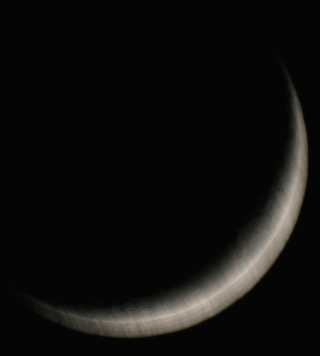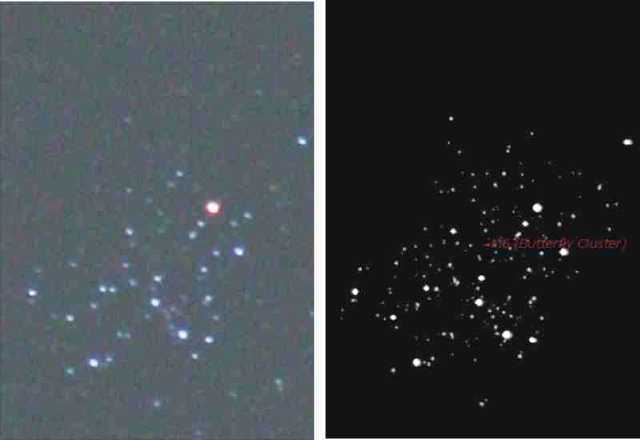Last updated: 17 December 2007
|
Last updated: 17 December 2007 |
Subject: RE: Astrophotography w/Canon XTi Sent: Thursday, December 13, 2007 08:56:55 From: French, Winsor (WFrench@nuvox.com) I don't know if you remember me, but I sent you an E-Mail back in Oct About taking Astro photos wit my new 35mm Canon Rebel XTi. Anyway..You were 100% correct. I have GOT TO get a stable, rock solid tripod if I want to take any decent photos. So I'm looking into an Azimuth mount for my Orion Apex 102mm scope. It just ain't working... Anyway I have been able to take a few decent shots , but those have been 3 out of 30... Winsor...........Mike here: Yep, a stable mount will make a LOT of difference!
And:
I took them Wed nite from my driveway.

Subject: RE: Astrophotography w/Canon XTi Sent: Monday, October 29, 2007 09:59:05 From: Dave Wallace (d_wallace@ecrm.com) (In reply to an inquiry from WFrench your ETX astrophotography area.) The Canon XTi has a mirror lock-up feature that will probably serve to avoid vibrations and is simpler to use than the hat trick. The remote is useful, too, in that it decouples your body from the telescope, but mirror lock-up is the way to go: this feature will flip the mirror several seconds before the shutter fires. Without being able to track and when using a long focal-length telescope, you're going to have significant problems with sky motion for exposures longer than 1/4 second. DSOs are probably out, but planets and the moon will be fine, even at fairly low ISO values. I'd recommend playing around at ISO 400 and exposures from 1/10 to 1/250th until you like what you see. You want a T ring for an EOS mount. Use the RED dot on the mount to align the adapter when attaching it to the camera; the WHITE dot is only for EF-S lenses.
Subject: Astrophotography w/Canon XTi Sent: Thursday, October 25, 2007 13:51:51 From: French, Winsor (WFrench@nuvox.com) Just finished browsing your Canon Astrophotography page I just ordered the Canon XTi 10.2 meg Camera this past week. I was doing some surfing on the web and found your site. I am looking forward to seeing how well the camera will work out. Originally I was going to use a standard 35mm SLR but due to age, and condition the camera wasn't going to work so I decided to get the Canon. I have two scopes an 8" Dob and a 103mm Mak/Cass spotting scope. They will both provide their challenges as neither one is computer driven. Should be fun?????? Got any helpful hints???? Winsor..Mike here: Of course, you will need the proper adapters. And you will be limited to short exposures since neither of your telescopes have a Right Ascension clock drive. I suggest starting with bright objects like the Moon, the Sun (assuming you have the proper solar filters), and the brighter planets.
And:
Thanks for the reply... I've got the camera adapter so I'm good there, but I still need to get a T-ring adapter, and I only have a Moon filter at this time. I've been thinking about getting a 1.25 UV but haven't done so yet. My plan is to focus [no pun intended] on taking sunsets, moon shots, and other types of long distance photos. Someday I might take the plunge and get a clock drive telescope, but for right now I'm just going to play around. As I have never gotten into photography this will be a leaning experience from day one. And fortunately I've purchased a great camera to play with. Have a great weekend... WinsorMike here: Unless you have really sturdy mounts you will need to avoid vibrations from the "mirror movement". What you need to do is use the "hat trick" method: hold a "hat" (I use a piece of black cardboard) over the objective of the telescope, open the shutter ("bulb" setting), let the vibrations settle down, flip the "hat" out of the way for the exposure, then cover the objective again, and close the shutter. On bright objects like the Moon it will be a challenge to get a short enough exposure but with practice it can be done.
And:
I was planning on getting a remote control for the camera so there hopefully won't be the possibility of vibration when I take a photo. Or are you saying it's just a mechanical aspect of the camera? As to the Moon, since the XTi has various shutter speeds it would seem [yeh right] the Moon would be easy to shoot! From what I've been reading [I have also bought a book on Astrophotography] a standard SLR would have been better than a digital but I thought for overall use the XTi was a better idea. Also from what I've read, it looks like I've bought a really nice camera that takes really nice photographs....BUT.... astrophotography is a really challenging type of photography [especially when using a digital camera] and can be very frustrating! It ain't like you "point and shoot" and you get these really kool photographs like you see in National Geographic. Well the camera should be here this weekend. It will probably take a few weeks to get use to it. I'll get the T-ring, and then it will be "point and shoot" and see what happens. Thank goodness we now have digital cameras where we can see what we're doing and make corrections as we go alone instead of wasting $6,zillion dollars in film developing. One last note, I have also read that I will probably need a "focal reducer" As my Mak is an F12 and for photos I really should be in the F4-6 range. There goes another $160.00.Mike here: The movement of the mirror is mechanical so it will likely induce vibrations in the telescope, resulting in blurred images. At really short exposures you may not notice it but at longer exposures you will. And yes, a focal reducer can help, especially with fainter objects.
Subject: Butterfly Cluster Sent: Saturday, September 22, 2007 18:44:47 From: Agustn Abeledo (agustin.abeledo@gmail.com) On the left, a picture taken with a Canon EOS Digital Rebel 200mm piggybacked on an ETX 125 with a homemade adapter. 30 sec shot at 800 ISO. Cloudy, bright night. Buenos Aires, Argentina. On the right, a picture of the cluster extracted from "Starry Night Backyard" software. I must say I'm quite satisfied with the tracking. However I didn't get the chance to try higher magnifications. Next time I guess...

Go to the February-August 2007 Canon DSLR Astrophotography Page.
Go to the 2006 Canon DSLR Astrophotography Page.
Go to the 2005 Canon DSLR Astrophotography Page.
Go back to the Astrophotography Page.
Go back to my ETX Home Page.